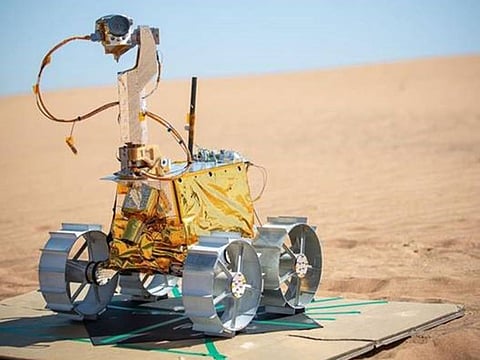MBRSC team getting ready for Rashid Rover’s launch in few days
Lunar rover launch date is set for Nov. 22 or later from Cape Canaveral, Florida

Dubai: A team from Mohammed bin Rashid Space Centre (MBRSC) are now at Kennedy Space Centre in Cape Canaveral, Florida for the launch of UAE-made Rashid Rover to moon later this month.
MBRSC director general Salem Al Marri has tweeted: “In Florida this week with our team, we are preparing for the launch of the 1st Emirati mission to the Moon. We will also attend the #Artemis1 launch and we are preparing with NASA for Sultan AlNeyadi’s launch next year.”
US Space Agency’s Artemis 1 had a successful lift-off on Wednesday while UAE astronaut Sultan AlNeyadi will embark on a six-month mission to the International Space Station (ISS) by spring of 2023.
Journey to the moon
The Emirati lunar rover will be delivered to the lunar surface by Japanese lander Hakuto-R M1, aboard a SpaceX Falcon 9 rocket that will lift off from Cape Canaveral on November 22 or at a later date from Cape Canaveral, Florida.
Previously, a launch window between November 9 to 15 was given, but Tokyo-based space company ispace, creator of Hakuto-R, said “a new date would allow for best preparation, when considering the fuel-loading schedule for the lander and launch date availability.”
Aside from Rashid Rover, the Japanese lander will also be carrying other government and commercial payloads, including a “transformable lunar robot” the size of a baseball from Japan’s space agency JAXA.
Compact rover
Designed and developed fully by an Emirati team, Rashid Rover is said to be the world’s most compact rover to land on the moon. Its primary goal is to study the moon’s plasma and to provide answers about moon dust, the lunar surface, mobility on the moon’s surface, and how different surfaces interact with lunar particles.
Rashid Rover is equipped with the latest technologies and innovative devices and distinguished by its ability to resist the lunar surface temperature, which drops to as low as minus 173 degrees Celsius, from as high as 127 degrees Celsius, when sunlight hits the moon’s surface.
It has 3D cameras, advanced motion system, sensors, communication system that are powered by solar panels. There are four cameras that move vertically and horizontally, including two main cameras, a microscope camera, and a thermal imaging camera. Its sensors will analyse the properties of lunar soil, dust, radioactivity, electrical activities, as well as the rocks on the moon surface.
Its advanced motion system is designed to enhance the efficiency of the rover’s movement on the moon and ability to overcome natural barriers as well as resistance to changing temperatures.
Sign up for the Daily Briefing
Get the latest news and updates straight to your inbox



